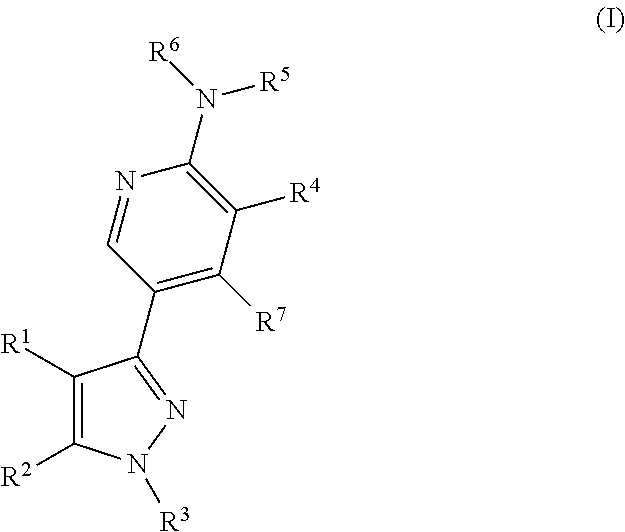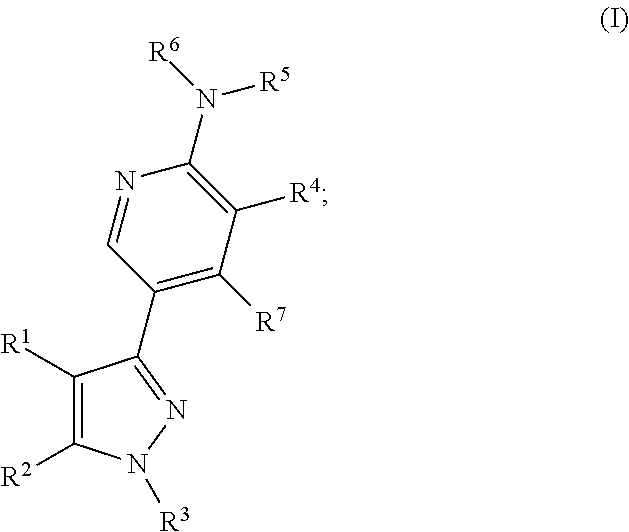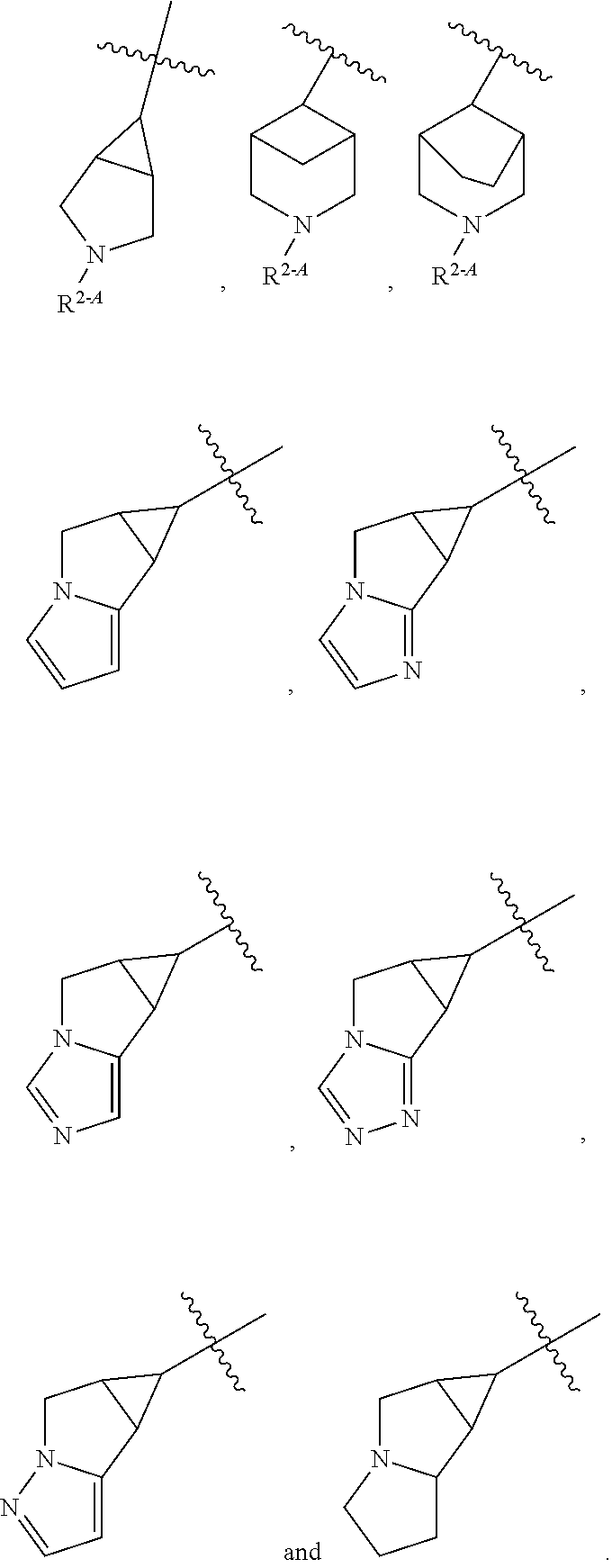3-substituted pyrazoles and use as DLK inhibitors
- Summary
- Abstract
- Description
- Claims
- Application Information
AI Technical Summary
Benefits of technology
Problems solved by technology
Method used
Image
Examples
example 1
Preparation of Intermediates
Preparation of 3-(cyclopropylmethoxy)-5-(4,4,5,5-tetramethyl-1,3,2-dioxaborolan-2-yl)pyridin-2-amine
[0395]
Step 1: 5-bromo-3-(cyclopropylmethoxy)pyridin-2-amine
[0396]To a stirred solution of 2-amino-5-bromopyridine-3-ol (25 g, 132.9 mmol) in dichloromethane (150 mL) was added (bromomethyl)cyclopropane (35.88 g, 265.8 mmol), aliquat (7.5 g) and 40% aqueous sodium hydroxide (150 mL) at RT, followed by stirring for 16 h. The reaction mixture was diluted with water (500 mL) and extracted with dichloromethane (2×500 mL). The combined organic layers were concentrated to dryness in vacuo and the resulting residue was purified by column chromatography (silica gel, 100-200 mesh, 25% ethyl acetate in hexane) affording 5-bromo-3-(cyclopropylmethoxy)pyridin-2-amine as and off white solid (15 g, 47%): 1H NMR (300 MHz, DMSO-d6) δ 7.61 (s, 1H), 7.19 (s, 1H), 5.81 (s, 2H), 4-3.8 (m, 2H), 1.35-1.1 (m, 1H), 0.65-0.55 (m, 2H), 0.2-0.4 (m, 2H).
Step 2: 3-(cyclopropylmethoxy)-5...
example 2
General Methods A-AH
Method A
Preparation of 5-(1-isopropyl-5-((1R,5S,6r)-3-(oxetan-3-yl)-3-azabicyclo[3.1.0]hexan-6-yl)-1H-pyrazol-3-yl)-3-(trifluoromethyl)pyridin-2-amine (134)
[0476]
Step 1—Synthesis of (1R,5S,6r)-3-tert-butyl 6-ethyl 3-azabicyclo[3.1.0]hexane-3,6-dicarboxylate
[0477]
[0478]To a solution of tert-butyl 2,5-dihydro-1H-pyrrole-1-carboxylate (0.100 kg, 0.592 mol) and rhodium(II) acetate dimer (3 g, 0.007 mol) in anhydrous dichloromethane (1.5 L) was added a solution of ethyl diazoacetate (101 g, 0.888 mol) in dichloromethane (500 mL) over 10 h. The reaction was filtered through Celite®, and the filtrate was concentrated in vacuo. Purification of the resulting residue by flash column chromatography (solvent gradient: petroleum ether→50% ethyl acetate in petroleum ether) afforded (1R,5S,6r)-3-tert-butyl 6-ethyl 3-azabicyclo[3.1.0]hexane-3,6-dicarboxylate (71 g, 47% yield) as a clear yellow oil.
[0479]1H NMR (400 MHz, CDCl3): δ 4.12 (q, J=7.2 Hz, 2H), 3.58-3.69 (m, 2H), 3.40 ...
example 3
[0733]The compounds disclosed in Table A were prepared following the General Methods A-AH as described above in Example 2 with modifying the starting reactants in those methods as would be known to one skilled in the art as necessary to arrive at the compounds in Table A.
TABLE AMSNo.Structure1H NMR[MH]+Method117(400 MHz, CDCl3): δ 8.55 (d, J = 2.1, 0.8 Hz, 1H), 8.11 (d, J = 2.2, 0.7 Hz, 1H), 6.01 (d, J = 0.6 Hz, 1H), 4.95 (s, 2H), 4.69 (hept, J = 6.7 Hz, 1H), 3.56-3.49 (m, 2H), 3.37 (s, 3H), 3.33-3.17 (m, 2H), 2.82-2.62 (m, 3H), 2.57-2.43 (m, 2H), 2.27- 2.13 (m, 1H), 1.79-1.65 (m, 2H), 1.51 (d, J = 6.7 Hz, 6H)510AE153(400 MHz, CD3OD): δ 8.13- 8.08 (m, 1 H), 7.95 (s, 1 H), 6.26 (s, 1 H), 5.03-4.99 (m, 1 H), 4.75-4.72 (m, 2 H), 4.66-4.63 (m, 2 H), 3.88-3.85 (m, 1 H), 3.32- 3.31 (m, 1 H), 3.30-3.27 (m, 1 H), 2.73-2.68 (m, 2 H), 2.61-2.58 (m, 2 H), 2.48-2.45 (m, 2 H), 2.28- 2.27 (m, 1 H), 1.95-1.90 (m, 4 H), 1.86-1.76 (m, 1 H), 1.20-1.08 (m, 2 H), 0.80-0.70 (m, 2 H)392.2B152(400 MHz, CD...
PUM
 Login to View More
Login to View More Abstract
Description
Claims
Application Information
 Login to View More
Login to View More - R&D
- Intellectual Property
- Life Sciences
- Materials
- Tech Scout
- Unparalleled Data Quality
- Higher Quality Content
- 60% Fewer Hallucinations
Browse by: Latest US Patents, China's latest patents, Technical Efficacy Thesaurus, Application Domain, Technology Topic, Popular Technical Reports.
© 2025 PatSnap. All rights reserved.Legal|Privacy policy|Modern Slavery Act Transparency Statement|Sitemap|About US| Contact US: help@patsnap.com



